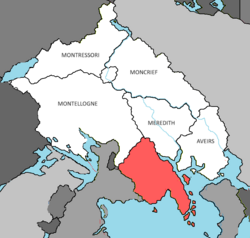Selleaux (province)
Selleaux
Selleaux | |
|---|---|
 Selleaux in Avergnon | |
| Country | |
| Capital | Selleaux |
| Largest city | Selleaux |
| Population | |
| • Total | 18,878,200 |
Selleaux is a province of Avergnon located in the southernmost region of the country, with a coastline along the Siena Bay and hosting a border with Shoassau, the holy city of Montemera, and Drambenburg. Its provincial capital, largest city, and namesake is Selleaux, with other major cities including Monaford, Eppelborn, and Oftcote. The cities are known as centers of knowledge, with world class libraries, colleges, and debate houses. Many upper class individuals from the province pursue careers in the Avergnonian political scene from birth. With the wealthiest of families paying oftentimes exorbitant sums of money to send their children to prestigious foreign political training institutions. Most notable as an example of this practice may be Franz Selleaux the current Avergnonian Elected Archon who attended the University of Tofino.
Selleaux is well known for its vineyards and farmland, with larger vineyards often employing entire villages to cultivate and prune fields that are grown to keep pace with national and international demand of the famous Selleauxvian Wines. Selleaux has two main geographical regions: the coastal basin plain, and the fertile inland plain. The first consists mainly of sand dunes and clayey alluvial soils in the polders. Polders are areas of land, close to or below sea level that have been reclaimed from the sea, from which they are protected by dikes or, a little further inland, by fields that have been drained with canals. With similar soils along the lowermost basin starts the inland plain, a smooth, slowly rising fertile area irrigated by many waterways that reaches an average height of about five metres (16 feet) above sea level with wide valleys of its rivers upstream as well as the Meine region to the west along the Drambenburgian border having sandy soils at altitudes around thirty metres.
